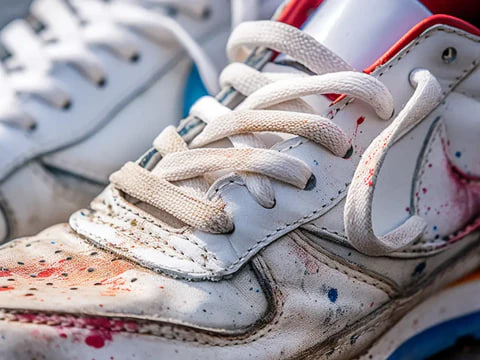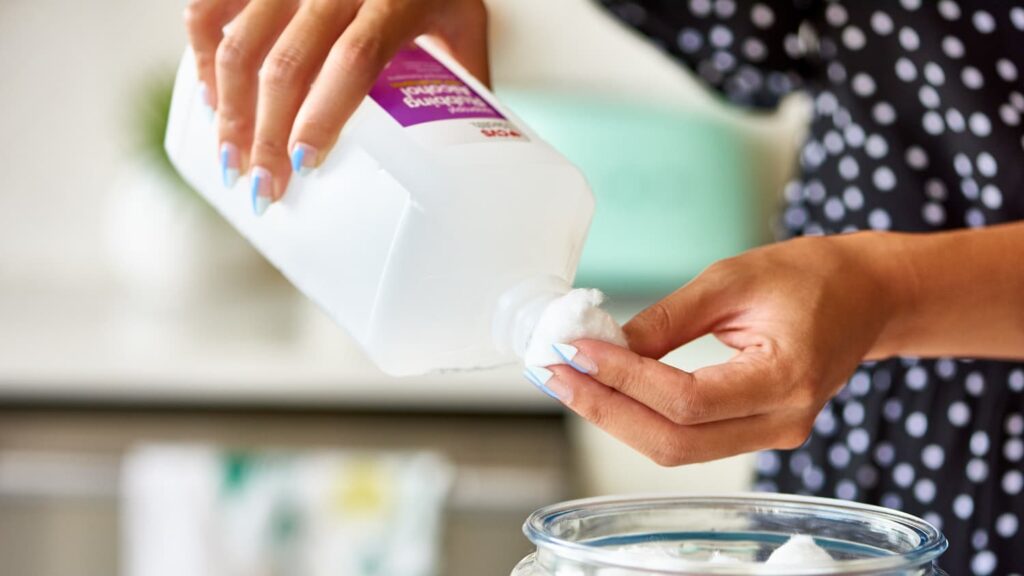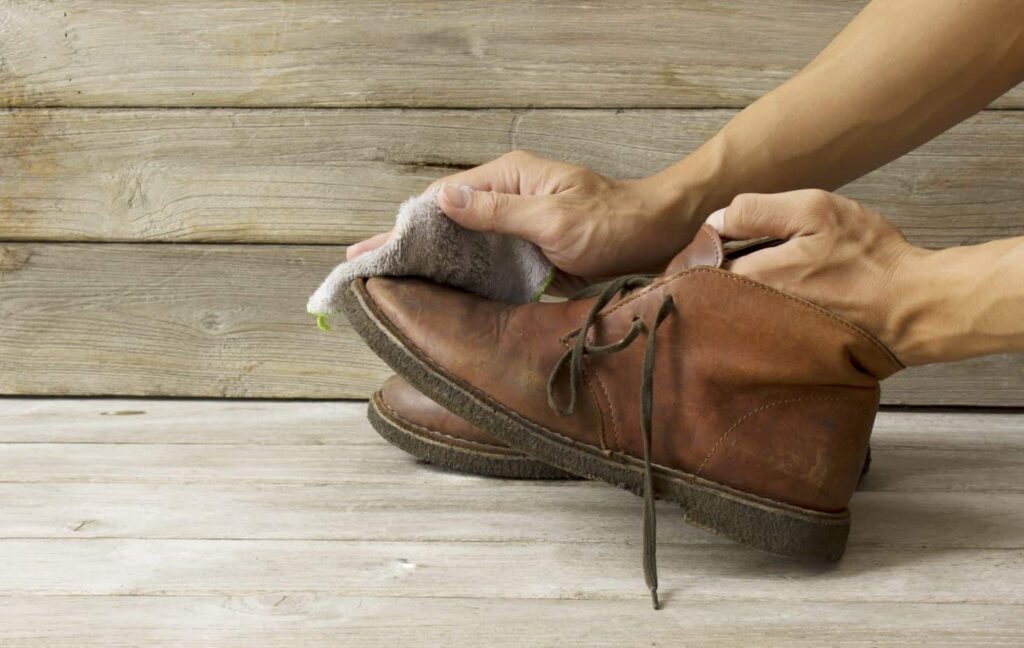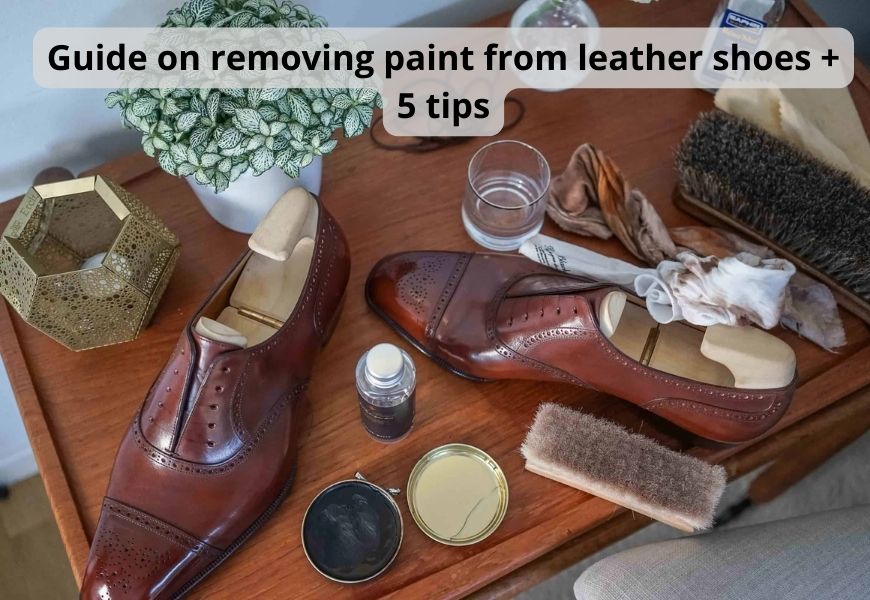How to remove paint from shoes? Discover the essential steps and expert tips to effectively remove paint from leather shoes and restore their pristine condition.
Contents
- 1 Step 1: assessing the paint type
- 2 Step 2: preparation to remove paint stains
- 3 Step 3: How to remove paint from shoes – begin with gentle methods
- 4 Step 4: using dish soap or leather cleaner
- 5 Step 5: rubbing alcohol for water-based or spray paint
- 6 Step 6: acetone or nail polish remover for oil-based or acrylic paint
- 7 Step 7: leather conditioner after removing paint stains
- 8 Tip 1: removing stubborn or dry paint stains
- 9 Tip 2: protecting shoes from paint stains
- 10 Tip 3: regular cleaning and maintenance routine
- 11 Tip 4: storing shoes properly to avoid future incidents
- 12 Tip 5: using a vinegar solution for paint removal
- 13 Conclusion
- 14 FAQ
Step 1: assessing the paint type
Differentiating between water-based, acrylic, or oil-based paints guarantees that the best removal techniques are applied for optimal outcomes without causing damage to the leather.

Different paints on leather
Water-based paint stain:
- For leather items, a water-based paint stain (like latex paint) is more typical.
- It may be more flexible and dry comparatively quickly.
- Latex paint typically smears or dissolves when exposed to water or mild soaps.
Acrylic paint or oil paint stain:
- Although they are less popular, oil paint and acrylic paint can be used for customizing or unique designs.
- They are frequently more robust and dry more slowly.
- Stronger solvents like acetone or nail polish remover may be needed for removal.
Techniques to identify paint type
Spot test:
- Spoon a tiny bit of water onto a discrete section of the shoe.
- Gently rub the wet area; if the paint smears or disappears, it is probably water-based.
Use of solvents:
- Put a tiny bit of acetone or rubbing alcohol on an area of the shoe that is not visible.
- If it dissolves or softens, it may be an indication that it is an oil-based paint.
Observation and smell: pay attention to the paint’s texture and scent. Oil-based paint typically has a thicker consistency and a more overpowering chemical smell than water-based paints.
Step 2: preparation to remove paint stains
Before trying to remove paint from shoes leather stains, adequate preparation is essential to ensure the efficacy and safety of the procedure.

Gathering necessary supplies for removing paint from leather shoes
Protective gear:
- Put on rubber or latex gloves to keep your hands safe.
- When working with chemicals or powerful solvents, wear safety goggles.
Cleaning materials:
- A clean cloth to use for light cleaning.
- Use leather cleanser, baby oil, or dish soap that is appropriate for the type of shoe.
- Using acetone or alcohol to rub particular paint kinds.
- For finer work, use a soft-bristled brush or cotton swab.
- A paper towel to use as a drying cloth.
Protective agents:
- After washing, use a leather cream or conditioner to hydrate the leather.
- For further protection, use leather protectors or waterproofing spray.
Miscellaneous:
- Use a newspaper or other covering to keep the work surface safe.
- Solvent fumes can be dispersed using a ventilated environment or adequate ventilation.
Pre-clean inspection of shoes
Surface examination:
- Make sure not to miss any spots when looking for paint marks on the entire shoe surface.
- Take note of the size and placement of any paint stains or markings on the leather.
Assessing shoe condition:
- Examine the leather’s general state, keeping an eye out for any weak areas, peeling, or cracks.
- Determine any prior damage that may have an impact on the paint removal procedure.
Colorfastness test: to make sure the shoe’s color won’t bleed or fade after cleaning, conduct a colorfastness test in a discrete area using a light cleaner or solvent.
Documentation: before beginning the removal procedure, take pictures of the paint stains for future reference and comparison once cleaning is finished.
Removing paint from leather
Executing a step-by-step process of removing paint is crucial for effectively restoring your shoes to their pristine condition.
Step 3: How to remove paint from shoes – begin with gentle methods
Dry cloth or soft brush:
- First, use a dry, clean cloth or a soft-bristled brush to carefully brush off any stray paint particles.
- To stop the paint from becoming further embedded in the leather, don’t scrape too vigorously.
Clean cloth and mild soap:
- Use a mild soap made for leather or moisten a clean cloth with warm water.
- To remove surface-level paint, gently dab the damaged area with a damp cloth rather than rubbing it vigorously.
Step 4: using dish soap or leather cleaner
Proper dilution and application:
- As directed by the manufacturer, dilute the leather cleaner, dish soap, or baby oil.
- Using a gentle cloth, apply the solution and gently blot the paint-stained area.
- To lift the paint without spreading it more, wipe or pat the area rather than rubbing forcefully.
Step 5: rubbing alcohol for water-based or spray paint
Testing on a small area:

- How to remove spray paint from shoes? Put a tiny bit of rubbing alcohol on a piece of cloth.
- Gently rub the afflicted area, taking care not to harm or discolor the leather.
Patience and persistence: use rubbing alcohol on the leather by dabbing and patting repeatedly until you lift the water-based or spray paint from leather.
Step 6: acetone or nail polish remover for oil-based or acrylic paint
How to remove acrylic paint from shoes? Spot testing: to check if acetone or nail polish remover is compatible with the leather, apply a small amount to a hidden part of the shoe.
Careful application:
- Apply the acetone or remover to the paint-stained area gently using a cotton swab or soft cloth.
- Work in little pieces and gently remove paint without applying too much force.
Step 7: leather conditioner after removing paint stains
- Nourishing the leather: to help the leather regain its suppleness and moisture after properly removing paint stains, use a second cotton swab to apply a premium leather conditioner.
- Even application: use a gentle cloth to lightly apply the conditioner, making sure that the entire surface of the shoe is covered.
- Drying with a paper towel: using a clean paper towel, carefully buff the leather to restore its sheen and luster after drying it.
Tip 1: removing stubborn or dry paint stains
Softening the dry paint:
- To soften dried paint, dab it with a clean cloth soaked in warm water and soap.
- Give it a few minutes to settle so that the dried paint can come off the leather.
Gentle scrubbing with a soft brush:
- Gently scrub the area with softened paint using a brush with soft bristles.
- Continue working without using too much effort until the paint comes off the leather.
Repeated application if necessary:
- Reapply warm, soapy water and gently scrub the remaining paint if it continues to be obstinate.
- To save the leather from being harmed, take your time and be patient.
Rinse and condition:
- Wipe off the area with a damp cloth after removing the paint to get rid of any soap residue.
- After treating the affected region, use a paper towel to wipe off the surface and apply a leather conditioner to restore moisture and suppleness.
Tip 2: protecting shoes from paint stains
Covering shoes during painting activities: using protective shoe covers, an old cloth, or plastic wrap to cover your shoes while painting projects or in areas where wet paint may splatter is a good idea.
Maintaining distance and awareness:
- Maintain a safe distance from surfaces when painting or in locations where paint may splatter to avoid getting paint on your shoes by accident.
- Keep an eye out and be mindful of your surroundings to prevent accidental contact with wet paint.
Quick cleanup of excess paint:
- If spills happen by accident, quickly wipe off any excess paint by dabbing the surface with a clean, dry towel.
- Removing the wet paint by rubbing it off will allow it to seep further into the leather.
Avoiding direct contact:
- Avoid touching the leather surface or spreading the paint further if it splatters and do not attempt to remove paint.
- Rather, give the paint stains time to cure before attempting to remove them, since touching them right away could make things worse.
Tip 3: regular cleaning and maintenance routine
Scheduled cleaning sessions:
- Create a schedule for routinely cleaning your shoes, regardless of any obvious stains or scratches.
- Dust and debris can be removed from the surface of the shoes using a soft brush or cloth.

Appropriate cleaning products:
- Invest in a mild soap or high-quality commercial leather cleaner meant for shoe maintenance.
- Comply with the product’s instructions to guarantee safe usage and prevent harm.
Gentle cleaning techniques:
- Use a soft brush or a damp cloth to gently wipe the shoes to get rid of any surface stains or dirt.
- Steer clear of using too much water or harsh chemicals as they could damage the leather.
Drying and conditioning:
- After cleaning, let the shoes air dry naturally.
- Use the suggested leather conditioner to keep the leather supple and shield it from drying out or breaking.
Tip 4: storing shoes properly to avoid future incidents
Use shoe bags or boxes: to keep shoes safe from exposure and dust put them in shoe boxes with discrete compartments or in breathable fabric bags.
Elevate storage: to keep shoes away from dampness and grime, place them on a shelf or rack that is higher than the floor.
Climate consideration: avoid keeping shoes in extremely high or low temperatures since these can eventually harm the leather.
Tip 5: using a vinegar solution for paint removal
Vinegar and water mixture:
- Mix equal parts white vinegar and warm water to create a solution.
- Gently dab the paint-stained area on the shoes with a cloth that has been dampened with the vinegar solution.

Mild paint-lifting properties:
- The slight acidity of vinegar can aid in removing paint from leather surfaces by softening and loosening paint.
- For the paint to come off more easily, let the solution sit for a few minutes.
Use colored vinegar with caution: if you plan to use colored vinegar (such as apple cider vinegar), test it first in a discrete area to be sure it won’t change the color of the leather dye.
Rinse and condition after use:
- Rinse the area with a fresh, damp cloth to get rid of any remaining vinegar solution after the paint begins to loosen.
- After washing, use a leather conditioner to keep the leather hydrated and from drying out.
Conclusion
Incorporating these meticulous steps and tips ensures removing paint effectively while preserving the integrity of your shoes for long-lasting wear.
FAQ
How do you get paint out of leather shoes?
To remove paint from leather, start by gently dabbing the area with warm water and dish soap. For latex and water-based paints, use soapy water. Rubbing alcohol works for spray paint or acrylic paint. For oil-based paint stains, use nail polish remover or acetone. Always test on a hidden area first to avoid damaging the leather
How do you get paint off shoes without ruining them?
Start with moderate cleaning solutions like warm water and soap to remove paint from leather. Instead of vigorously rubbing the paint, use blotting or dabbing techniques. To make sure that harsher solvents or paint removers won’t harm the shoe’s material, test them first in a discrete region.
Does paint remover damage leather?
Acetone and nail polish remover options are examples of paint removers that can harm leather if applied incorrectly or left on for an extended period. Before applying them to the paint-stained region, conduct a spot test in a discrete area to ensure there are no negative responses. To minimize possible damage, immediately rinse and condition the leather after applying paint removers.


